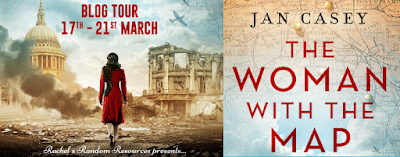February 1941
The world is at war and Joyce Cooper is doing her bit for the effort. A proud member of the ARP, it is her job to assist the people of Notting Hill when the bombs begin to fall. But as the Blitz takes hold of London, Joyce is called upon to plot the devastation that follows in its wake. Each night she must stand before her map and mark the trail of turmoil inflicted upon the homes and businesses she knows so well.
February 1974
Decades later, from her basement flat Joyce Cooper watches the world go by above her head. This is her haven; the home she has created for herself having had so much taken from her in the war. But now the council is tearing down her block of flats and she's being forced to leave. Could this chance to start over allow Joyce to let go of the past and step back into her life? (Synopsis courtesy of Goodreads)
Joyce Cooper’s experiences during the war are snippets of a world we’re not often privy to, particularly from a woman’s perspective. What I know about Notting Hill boils down to the movie, Notting Hill, so to say The Woman with the Map had been eye-opening for me would be an understatement! Night after night, brave individuals like Joyce did all they could for the war effort–even children who masqueraded as couriers–all in an effort to survive. I can’t even imagine what it must have been like to have everything you know and often, those you love, stripped from you. And even when that happened, there was only one option: to carry on.
I appreciated the two polar timeframes represented in Joyce’s life. We get the Joyce from 1941, a young woman faced with an impossible fate, and later the much older but not necessarily wiser Joyce, who has learned it’s best to shut out the world because the world has not been kind to her. It was an interesting contrast to see someone who is so steadfast in being alone and shutting everyone out, yet she wants to surround herself with the past, thereby embracing that painful time in her life. Her home reflects the past and despite all of that, it’s her safe zone. Jan Casey did a great job of showing that division, even more so when Joyce is forced to make a choice on where she wants to live going forward, and in letting go of her flat, she’s letting go of that painful past. Maybe.
Out of the two timelines, 1941 was my favorite. It was the building block for the future Joyce, and I felt like I was right there with her while she and the rest of her district endure constant bombings and destruction, and you wonder how anyone could withstand it. Given everything going on in our current world affairs right now, it really brought the reality of the present even closer to home. A constant thread through the pain and loss were continual glimpses of hope and endurance. It was reflected in Joyce’s familial relationships, her budding romance, and at times, when she notices little things like the fighting spirit of the crocus plant that grows in Notting Hill, attempting to make its way despite the frailty of the environment around it.
The Woman with the Map is a historical fiction novel, but it felt like it could be a true story told by the women who endured during World War II. Joyce was easily a recognizable representation from that era, and her story (and all it holds) was well told.
Thanks to Rachel's Random Resources for the book in exchange for an honest review.
Jan Casey's novels, like her first - The Women of Waterloo Bridge - explore the themes of how ordinary people are affected by extraordinary events during any period in history, including the present. Jan is fascinated with the courage, adaptability and resilience that people rise to in times of adversity and for which they do not expect pay, praise or commendation. Jan is also interested in writing about the similarities as opposed to the differences amongst people and the ways in which experiences and emotions bind humans together.
Jan was born in London but spent her childhood in Southern California. She was a teacher of English and Drama for many years and is now a Learning Supervisor at a college of further education.
When she is not working or writing, Jan enjoys yoga, swimming, cooking, walking, reading and spending time with her grandchildren.
Before becoming a published author, Jan had short stories and flash fictions published.
Visit Jan on Twitter.




No comments:
Post a Comment